Abstract
Antipeptide antibodies were raised against synthetic peptides corresponding to the amino acid sequences of eight surface predicted regions of the pilin proteins from Pseudomonas aeruginosa PAK and PAO. Four of the anti-PAK peptide antisera cross-reacted with strain PAO pili, while five anti-PAO peptide antisera cross-reacted with strain PAK pili. Only one region of the two pilin proteins (region 88-97) provided strain-specific antibodies when either strain PAK or strain PAO region 88-97 peptides were used to generate antipeptide antibodies. Our results clearly showed that cross-reactive and strain-specific antibodies cannot be based solely on the degree of homology in the aligned protein sequences. The majority of synthetic peptides bound to their homologous antipilus antiserum, suggesting that linear sequences play a significant role in the immunogenic response of native pili.
Full text
PDF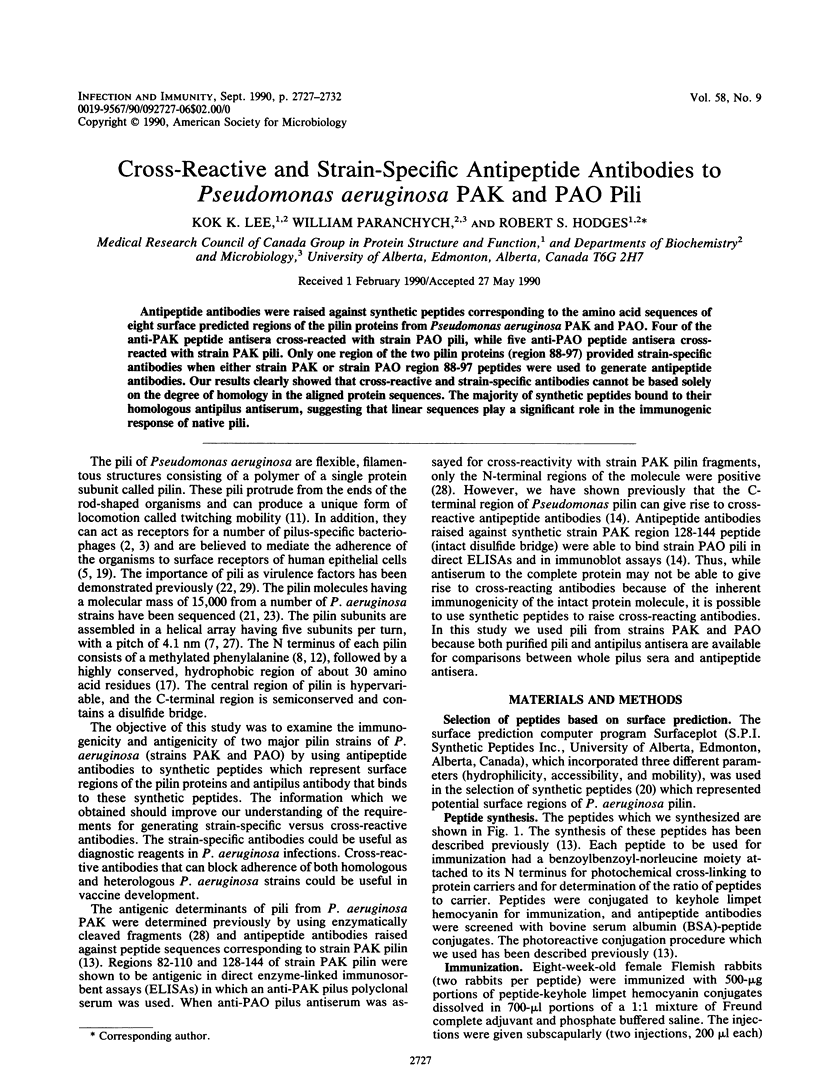
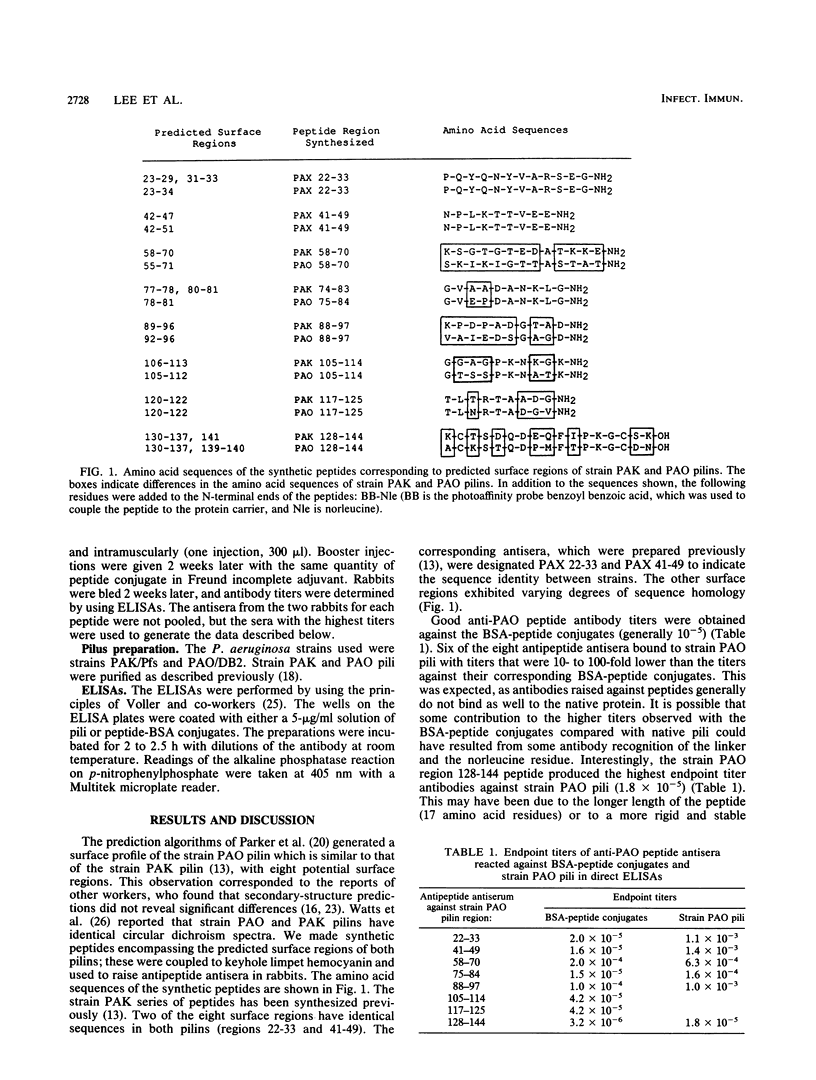
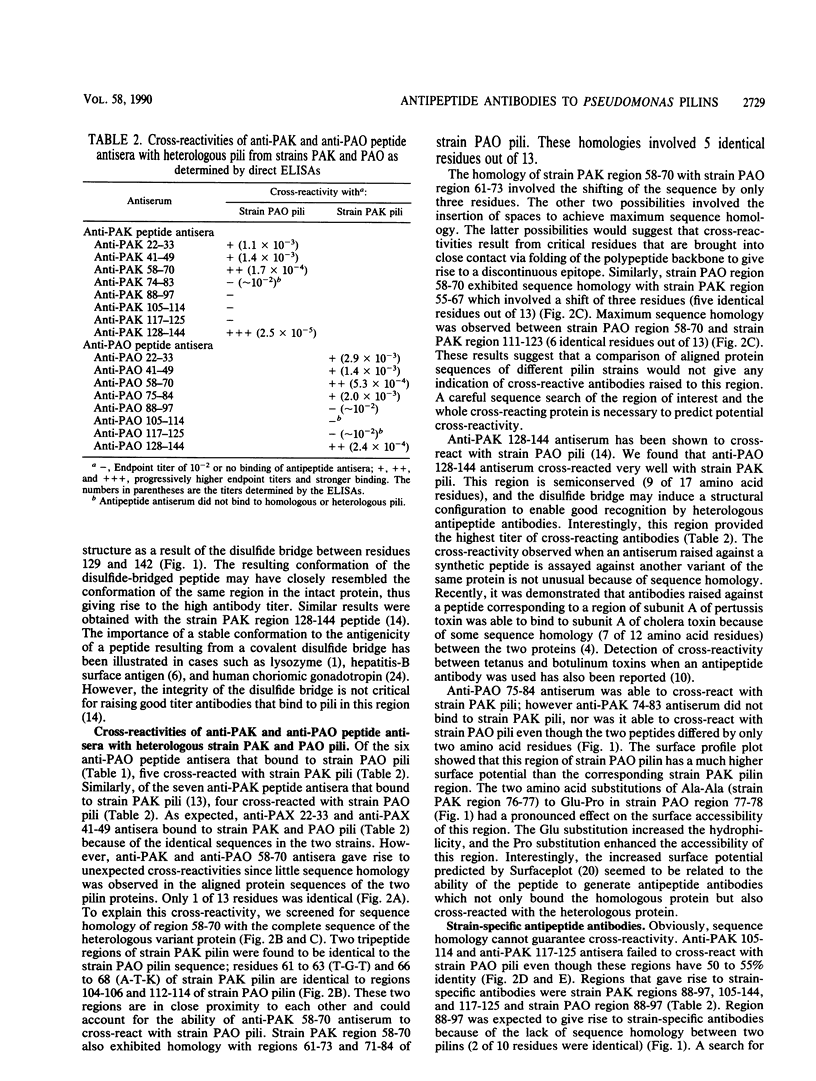
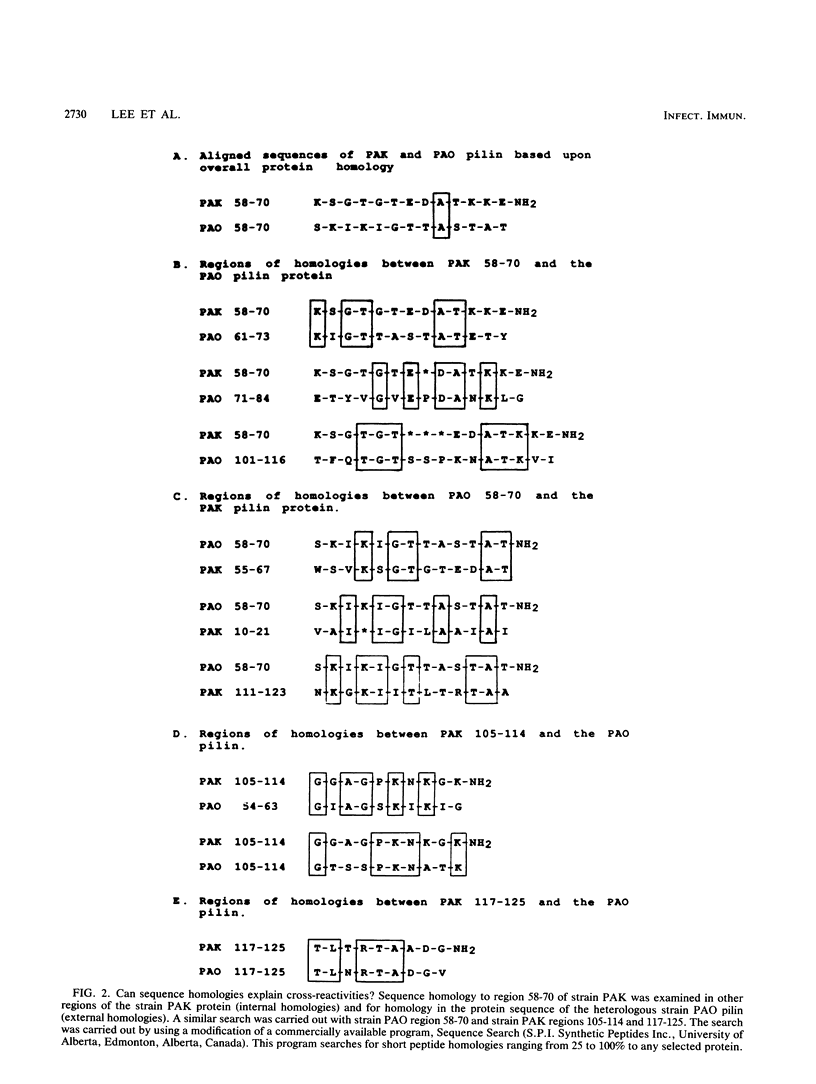
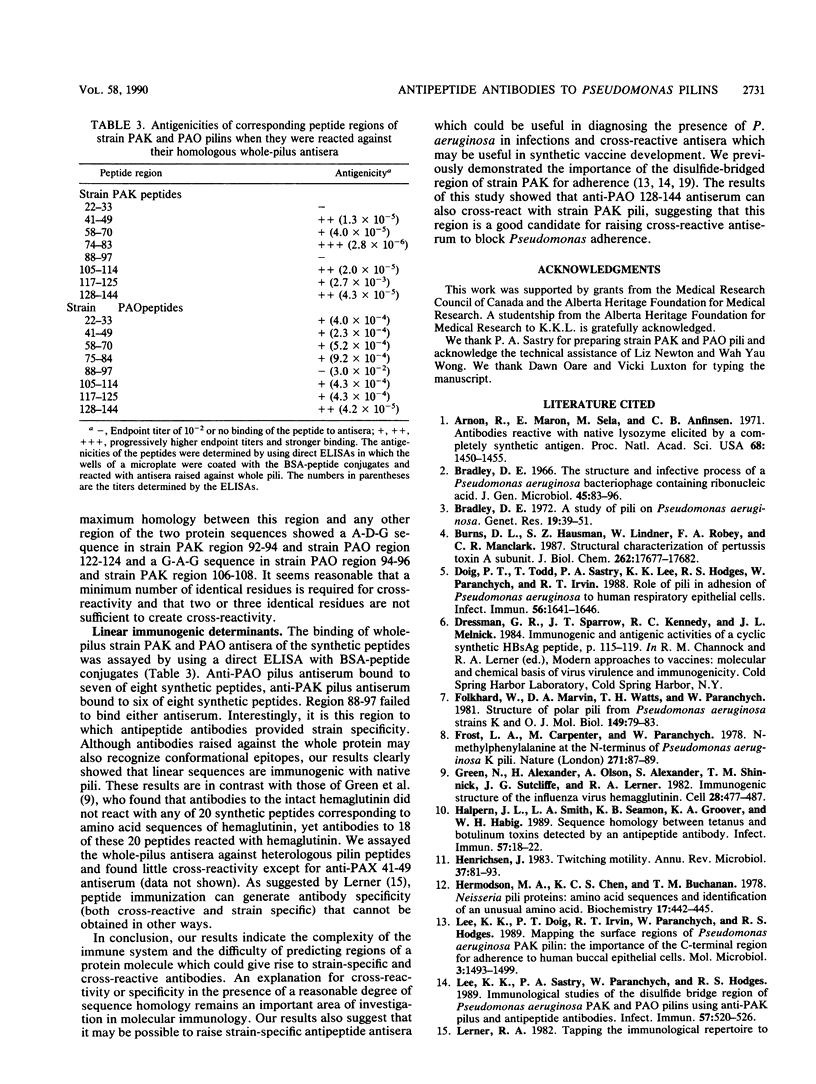
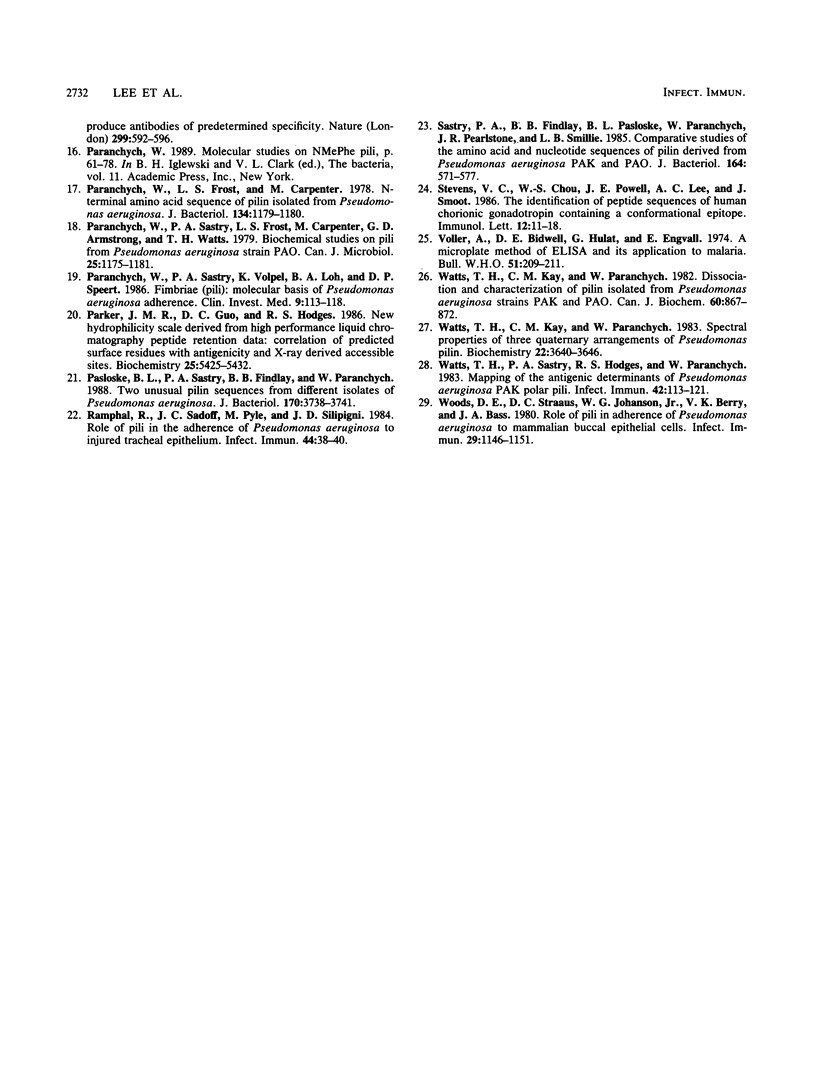
Selected References
These references are in PubMed. This may not be the complete list of references from this article.
- Arnon R., Maron E., Sela M., Anfinsen C. B. Antibodies reactive with native lysozyme elicited by a completely synthetic antigen. Proc Natl Acad Sci U S A. 1971 Jul;68(7):1450–1455. doi: 10.1073/pnas.68.7.1450. [DOI] [PMC free article] [PubMed] [Google Scholar]
- Burns D. L., Hausman S. Z., Lindner W., Robey F. A., Manclark C. R. Structural characterization of pertussis toxin A subunit. J Biol Chem. 1987 Dec 25;262(36):17677–17682. [PubMed] [Google Scholar]
- Doig P., Todd T., Sastry P. A., Lee K. K., Hodges R. S., Paranchych W., Irvin R. T. Role of pili in adhesion of Pseudomonas aeruginosa to human respiratory epithelial cells. Infect Immun. 1988 Jun;56(6):1641–1646. doi: 10.1128/iai.56.6.1641-1646.1988. [DOI] [PMC free article] [PubMed] [Google Scholar]
- Folkhard W., Marvin D. A., Watts T. H., Paranchych W. Structure of polar pili from Pseudomonas aeruginosa strains K and O. J Mol Biol. 1981 Jun 15;149(1):79–93. doi: 10.1016/0022-2836(81)90261-8. [DOI] [PubMed] [Google Scholar]
- Frost L. S., Carpenter M., Paranchych W. N-methylphenylalanine at the N-terminus of pilin isolated from Pseudomonas aeruginosa K. Nature. 1978 Jan 5;271(5640):87–89. doi: 10.1038/271087a0. [DOI] [PubMed] [Google Scholar]
- Green N., Alexander H., Olson A., Alexander S., Shinnick T. M., Sutcliffe J. G., Lerner R. A. Immunogenic structure of the influenza virus hemagglutinin. Cell. 1982 Mar;28(3):477–487. doi: 10.1016/0092-8674(82)90202-1. [DOI] [PubMed] [Google Scholar]
- Halpern J. L., Smith L. A., Seamon K. B., Groover K. A., Habig W. H. Sequence homology between tetanus and botulinum toxins detected by an antipeptide antibody. Infect Immun. 1989 Jan;57(1):18–22. doi: 10.1128/iai.57.1.18-22.1989. [DOI] [PMC free article] [PubMed] [Google Scholar]
- Henrichsen J. Twitching motility. Annu Rev Microbiol. 1983;37:81–93. doi: 10.1146/annurev.mi.37.100183.000501. [DOI] [PubMed] [Google Scholar]
- Hermodson M. A., Chen K. C., Buchanan T. M. Neisseria pili proteins: amino-terminal amino acid sequences and identification of an unusual amino acid. Biochemistry. 1978 Feb 7;17(3):442–445. doi: 10.1021/bi00596a010. [DOI] [PubMed] [Google Scholar]
- Inoue Y. K., Nishibe Y., Melnick J. L. Classification of Inoue-Melnick virus into three antigenic types. J Clin Microbiol. 1984 Jul;20(1):118–119. doi: 10.1128/jcm.20.1.118-119.1984. [DOI] [PMC free article] [PubMed] [Google Scholar]
- Lee K. K., Doig P., Irvin R. T., Paranchych W., Hodges R. S. Mapping the surface regions of Pseudomonas aeruginosa PAK pilin: the importance of the C-terminal region for adherence to human buccal epithelial cells. Mol Microbiol. 1989 Nov;3(11):1493–1499. doi: 10.1111/j.1365-2958.1989.tb00135.x. [DOI] [PubMed] [Google Scholar]
- Lee K. K., Sastry P. A., Paranchych W., Hodges R. S. Immunological studies of the disulfide bridge region of Pseudomonas aeruginosa PAK and PAO pilins, using anti-PAK pilus and antipeptide antibodies. Infect Immun. 1989 Feb;57(2):520–526. doi: 10.1128/iai.57.2.520-526.1989. [DOI] [PMC free article] [PubMed] [Google Scholar]
- Paranchych W., Frost L. S., Carpenter M. N-Terminal amino acid sequence of pilin isolated from Pseudomonas aeruginosa. J Bacteriol. 1978 Jun;134(3):1179–1180. doi: 10.1128/jb.134.3.1179-1180.1978. [DOI] [PMC free article] [PubMed] [Google Scholar]
- Paranchych W., Sastry P. A., Frost L. S., Carpenter M., Armstrong G. D., Watts T. H. Biochemical studies on pili isolated from Pseudomonas aeruginosa strain PAO. Can J Microbiol. 1979 Oct;25(10):1175–1181. doi: 10.1139/m79-182. [DOI] [PubMed] [Google Scholar]
- Paranchych W., Sastry P. A., Volpel K., Loh B. A., Speert D. P. Fimbriae (pili): molecular basis of Pseudomonas aeruginosa adherence. Clin Invest Med. 1986;9(2):113–118. [PubMed] [Google Scholar]
- Parker J. M., Guo D., Hodges R. S. New hydrophilicity scale derived from high-performance liquid chromatography peptide retention data: correlation of predicted surface residues with antigenicity and X-ray-derived accessible sites. Biochemistry. 1986 Sep 23;25(19):5425–5432. doi: 10.1021/bi00367a013. [DOI] [PubMed] [Google Scholar]
- Pasloske B. L., Sastry P. A., Finlay B. B., Paranchych W. Two unusual pilin sequences from different isolates of Pseudomonas aeruginosa. J Bacteriol. 1988 Aug;170(8):3738–3741. doi: 10.1128/jb.170.8.3738-3741.1988. [DOI] [PMC free article] [PubMed] [Google Scholar]
- Ramphal R., Sadoff J. C., Pyle M., Silipigni J. D. Role of pili in the adherence of Pseudomonas aeruginosa to injured tracheal epithelium. Infect Immun. 1984 Apr;44(1):38–40. doi: 10.1128/iai.44.1.38-40.1984. [DOI] [PMC free article] [PubMed] [Google Scholar]
- Sastry P. A., Finlay B. B., Pasloske B. L., Paranchych W., Pearlstone J. R., Smillie L. B. Comparative studies of the amino acid and nucleotide sequences of pilin derived from Pseudomonas aeruginosa PAK and PAO. J Bacteriol. 1985 Nov;164(2):571–577. doi: 10.1128/jb.164.2.571-577.1985. [DOI] [PMC free article] [PubMed] [Google Scholar]
- Stevens V. C., Chou W. S., Powell J. E., Lee A. C., Smoot J. The identification of peptide sequences of human chorionic gonadotropin containing a conformational epitope. Immunol Lett. 1986 Jan;12(1):11–18. [PubMed] [Google Scholar]
- Voller A., Bidwell D., Huldt G., Engvall E. A microplate method of enzyme-linked immunosorbent assay and its application to malaria. Bull World Health Organ. 1974;51(2):209–211. [PMC free article] [PubMed] [Google Scholar]
- Watts T. H., Kay C. M., Paranchych W. Dissociation and characterization of pilin isolated from Pseudomonas aeruginosa strains PAK and PAO. Can J Biochem. 1982 Sep;60(9):867–872. doi: 10.1139/o82-110. [DOI] [PubMed] [Google Scholar]
- Watts T. H., Kay C. M., Paranchych W. Spectral properties of three quaternary arrangements of Pseudomonas pilin. Biochemistry. 1983 Jul 19;22(15):3640–3646. doi: 10.1021/bi00284a016. [DOI] [PubMed] [Google Scholar]
- Watts T. H., Sastry P. A., Hodges R. S., Paranchych W. Mapping of the antigenic determinants of Pseudomonas aeruginosa PAK polar pili. Infect Immun. 1983 Oct;42(1):113–121. doi: 10.1128/iai.42.1.113-121.1983. [DOI] [PMC free article] [PubMed] [Google Scholar]
- Woods D. E., Straus D. C., Johanson W. G., Jr, Berry V. K., Bass J. A. Role of pili in adherence of Pseudomonas aeruginosa to mammalian buccal epithelial cells. Infect Immun. 1980 Sep;29(3):1146–1151. doi: 10.1128/iai.29.3.1146-1151.1980. [DOI] [PMC free article] [PubMed] [Google Scholar]


